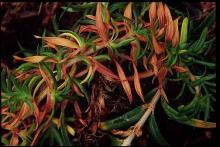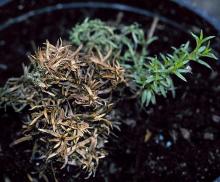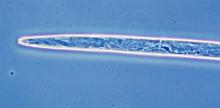Cause The nematode Ditylenchus dipsaci enters through natural openings, such as stomata, of young shoots and through wounds. It lives and feeds inside the stem, moves up as the shoot grows, and can exist under the seed coat. It can infect many hosts. Movement and reproduction rates are high between 69°F and 77°F. The nematode can be spread via contaminated soil or media, water, garden tools, shoes, and infested seed. Detached or dried leaves can also serve as a source of the nematode. The larval stage can survive several years in a dry state (anabiosis). The problem has been diagnosed a few times by the OSU Plant Clinic. Phlox cultivars are not equally susceptible, and some cultivars seem to be immune.
Symptoms Abnormal growth is common. Leaves may be curled and/or wrinkled but of normal width, or they may be spindly to thread-like. Stems may be swollen near the tops while basal buds exhibit a stimulated growth. Plants can be stunted, fail to bloom, and die prematurely.
Cultural control
- Use clean plant material for propagation.
- Immediately remove and destroy infested plants.
- In the landscape, replace or sterilize soil before planting susceptible hosts back in the same site.
Chemical control No chemicals are labeled to treat greenhouse plants infected with this nematode.
- Basamid G is labeled to treat potting soils, seed, and propagating beds and soil media before planting, but it is not labeled for treatment once ornamental plants are planted in the soil or media.
- Foliar applied broad-spectrum insecticides have been effective. Check the PNW Insect Management Handbook for possible materials.
Reference LaMondia, J.A. 1999. Efficacy of insecticides for control of Aphelenchoides fragariae and Ditylenchus dipsaci in flowering perennial ornamentals. Journal of Nematology 31(4S): 644-649.




